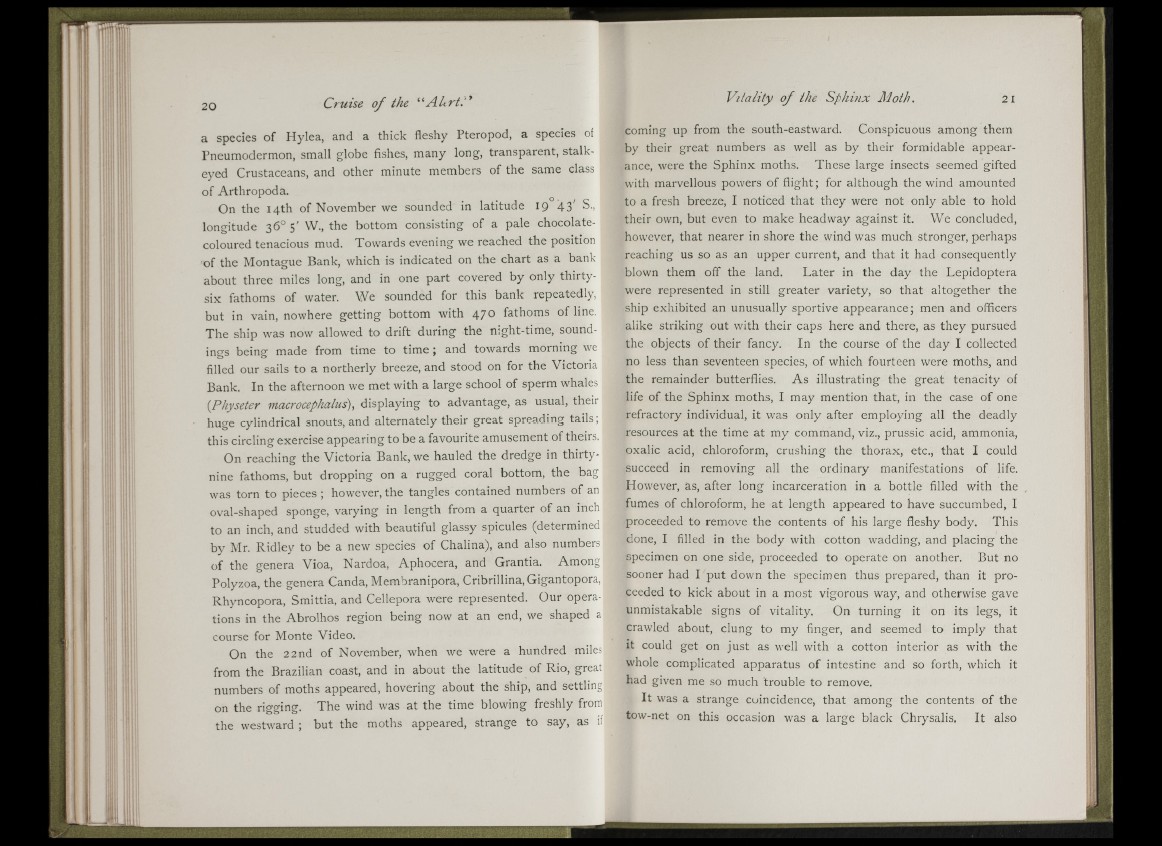
Hr" i: r
K
J'
1^
Ukip
1^'
1»^;)
20 Cruise of the “ A h r t.”
a species of Hylea, and a thick fleshy Pteropod, a species of
Pneumodermon, small globe fishes, many long, transparent, stalkeyed
Crustaceans, and other minute members of the same class
of Arthropoda.
On the 14th of November we sounded in latitude 19 43' S.,
longitude 36° 5' W., the bottom consisting of a pale chocolate-
coloured tenacious mud. Towards evening we reached the position
of the Montague Bank, which is indicated on the chart as a bank
about three miles long, and in one part covered by only thirty-
six fathoms of water. We sounded for this bank repeatedly,
but in vain, nowhere getting bottom with 47^ fathoms of line.
The ship was now allowed to drift during the night-time, sound-
incTs beins made from time to t ime; and towards morning we
filled our sails to a northerly breeze, and stood on for the Victoria
Bank. In the afternoon we met with a large school of sperm whales
{Physeter macrocephalus), displaying to advantage, as usual, their
huge cylindrical snouts, and alternately their great spreading tails;
this circling exercise appearing to be a favourite amusement of theirs.
On reaching the Victoria Bank, we hauled the dredge in thirty-
nine fathoms, but dropping on a rugged coral bottom, the bag
was torn to pieces ; however, the tangles contained numbers of an
oval-shaped sponge, varying in length from a quarter of an inch
to an inch, and studded with beautiful glassy spicules (determined
by Mr. Ridley to be a new species of Chalina), and also numbers
of the genera Vioa, Nardoa, Aphocera, and Grantia. Among
Polyzoa, the genera Canda, Membranipora, Cribrillina, Gigantopora,
Rhyncopora, Smittia, and Cellepora were represented. Our operations
in the Abrolhos region being now at an end, we shaped a
course for Monte Video.
On the 22nd of November, when we were a hundred miles
from the Brazilian coast, and in about the latitude of Rio, great
numbers of moths appeared, hovering about the ship, and settling
on the rigging. The wind was at the time blowing freshly from
the westward ; but the moths appeared, strange to say, as it
Vitality of the Sphinx Moth, 21
coming up from the south-eastward. Conspicuous among them
by their great numbers as well as by their formidable appearance,
were the Sphinx moths. These large insects seemed gifted
with marvellous powers of flight; for although the wind amounted
to a fresh breeze, I noticed that they were not only able to hold
their own, but even to make headway against it. We concluded,
however, that nearer in shore the wind was much stronger, perhaps
reaching us so as an upper current, and that it had consequently
blown them off the land. Later in the day the Lepidoptera
were represented in still greater variety, so that altogether the
ship exhibited an unusually sportive appearance; men and officers
alike striking out with their caps here and there, as they pursued
the objects of their fancy. In the course of the day I collected
no less than seventeen species, of which fourteen were moths, and
the remainder butterflies. As illustrating the great tenacity of
life of the Sphinx moths, I may mention that, in the case of one
refractory individual, it was only after employing all the deadly
resources at the time at my command, viz., prussic acid, ammonia,
oxalic acid, chloroform, crushing the thorax, etc., that I could
succeed in removing all the ordinary manifestations of life.
However, as, after long incarceration in a bottle filled with the
fumes of chloroform, he at length appeared to have succumbed, I
proceeded to remove the contents of his large fleshy body. This
done, I filled in the body with cotton wadding, and placing the
specimen on one side, proceeded to operate on another. But no
sooner had I put down the specimen thus prepared, than it proceeded
to kick about in a most vigorous way, and otherwise gave
unmistakable signs of vitality. On turning it on its legs, it
crawled about, clung to my finger, and seemed to imply that
it could get on just as well with a cotton interior as with the
whole complicated apparatus of intestine and so forth, which it
had given me so much trouble to remove.
It was a strange coincidence, that among the contents of the
tow-net on this occasion was a large black Chrysalis. It also